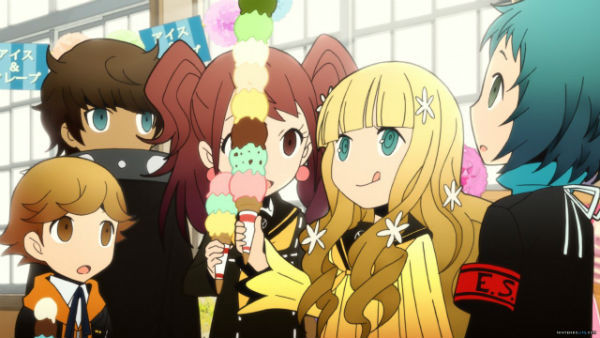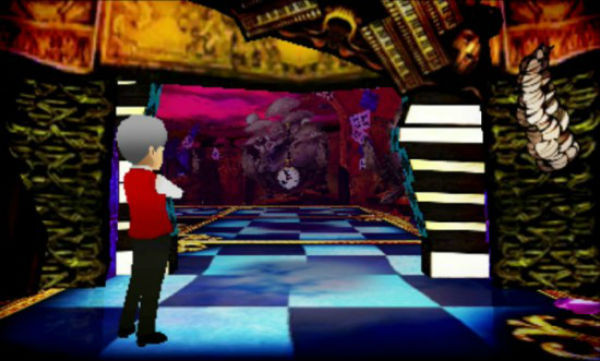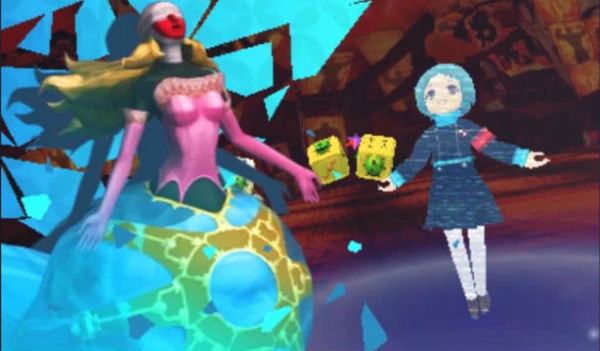What happens when your favorite characters from Persona 3 and Persona 4 meet up after being whisked away to a bizarre new world? They start investigating, of course! That’s what they specialize in, after all. That, and bashing otherworldly creatures’ brains in using super-powered entities known as Personas. Surprisingly, we’re not talking fanfiction here. This is Persona Q: Shadow of the Labyrinth, a cheeky tale that unites popular characters and the best elements of first-person dungeon crawling to tell a bizarre tale that could only work in the Persona universe. It’s a clear departure from the core Persona titles, but certainly worth checking out.

Through the power of the Velvet Room (and a rather strange occurrence surrounding it and its mysterious host, Igor) the members of Special Extracurricular Execution Squad (S.E.E.S.) of Persona 3 are transported to Yasogami High School. Why? The Investigation Team, or the Persona 4 crew, has been trapped there. Keep up! The two groups meet up and, while attempting to escape the school, stumble upon a series of labyrinths. Players have a choice between the two teams, and the plot varies depending on which group you use. New characters Rei and Zen are integral to the plot as well. Suffering from amnesia, they must fight through the labyrinths in an attempt to restore their pasts.
This game is first and foremost a dungeon crawler in the same vein as Etrian Odyssey. Players will spend most of their time in the labyrinths, exploring and fighting monsters known as Shadows as they attempt to restore the memory of Rei and Zen. The game, like most dungeon crawlers, requires a lot of self-starting from the player. You’re given a virtually empty map simply rife for exploration. While there are monsters, treasures, and rooms to explore already in place in the labyrinth itself, it’s up to you to work out which pathways you’re going to tackle, when you’re going to destroy larger field enemies, and even how the map you’re constantly creating on the second screen is going to look.

For instance, you can choose to mark a difficult enemy with whatever symbol you want, or number treasures or paths you’ve already taken. Shade specific spaces on your map that are iffy if you’d like to return to them later, like a locked door or possible pathway that could open up under the right conditions (after you’ve beaten a specific boss, for example). It’s up to you to figure out a system that works, and if you do a poor job, you’ve only yourself to blame when you find yourself lost in the labyrinth struggling to find your way. The game doesn’t hold your hand or tell you where to go - instead it forces you to look at things from a different perspective. It’s also purposefully disorienting, given the fact that you’re asked to explore in a first-person view rather than being given an isometric view of your surroundings. So if you’re already finding yourself getting lost in regular Persona games despite having a map to read, you may discover this isn’t the game for you.
But there are tons of reasons to soldier on, and most of them revolve around an RPG fan’s favorite thing: loot. The reward for all this diligence is that once a floor is completely explored, a treasure chest will appear. The chest is full to bursting with sweet equipment and items. Although, in theory, this sounds like a fairly straightforward process (depending on the floor) it can take up to five hours to completely clear an area. Some areas also have special conditions, such as not making eye-contact with sub-bosses, which will have you walking backwards to complete them. The environments are bursting with personality, from rusty, haunted schoolhouse motifs, to psychedelic Alice in Wonderland-inspired warrens. Unfortunately, in what appears to be an attempt at artificially lengthening the game, you can expect for some floors to be repeats of earlier designs.

Some floors of the labyrinth are crawling with F.O.E. (Field On Enemies) which wander about as the player moves. Players can either strategically avoid them by plotting their movements, (the map annotation feature is good for this) or sneak up on them for the a pre-emptive strike and annihilate them for a healthy dose of experience. You can really nail them by finding out their weakness, delivering critical hits, or by building up a Boost meter, which once filled, grants a character the Boost status. This allows for the usage of special skills at no HP or SP depletion and increases the chances of follow-up attacks and All-Out Attacks, souped-up combos that allow your party to strike at the same time to eliminate multiple enemies. The more characters in Boost status, the more likely these benefits are to occur.
Persona Q also introduces the Sub-Persona system. Players may receive additional Personas as loot from battles. They can be equipped as Sub-Personas, increasing HP and SP and allow the use of skills. They encompass the entire spectrum of the Shin Megami Tensei series, including elemental attacks like Bufu (ice) or Zio (lightning) or the ever-useful Dia (cure) and allow party members to access skills their main Persona may otherwise not be able to provide. For instance, Mitsuru Kirijo of Persona 3 may be able to use the Bufu spell thanks to her own special Persona, but unable to use Agi (fire) unless she equips a Sub-Persona with that skill equipped. Players can also fuse up to three Sub-Personas together to create a more powerful one. Utilizing this system is a key to successful gameplay, which allows characters access to powers they wouldn’t have otherwise.

Yasogami High School serves as the game’s hub. Here, players can converse with the other characters on their team, heal their party, and buy new weapons and equipment. You can still visit The Velvet Room (what’s left of it, anyway) to fuse new Personas as well, despite its having been left in disarray. As a mainstay of the Persona series, The Velvet Room has always been a constant across each new game, a sanctuary of sorts in which players visit to take care of all Persona-related business, and while it plays the same role in Persona Q, much of its eerie atmospheric tension is absent.
Similarly, don’t expect the rich social interaction of the main Persona entries, because it’s not here. Characters are more one-dimensional, and after 80 or so hours of gameplay the same joke about Chie loving meat or Teddie getting rejected by the ladies can get irritating. Elizabeth of the Velvet Room, however, is in rare form, making plenty of jokes at her twin brother’s expense and showcasing a side to her that simply didn’t exist in the other games. She’s a sardonic and elegant presence with sarcastic quips here and there that’ll have you giggling not twenty minutes into your first labyrinth, especially when she forces brother Theodore into a girly apron and stations him in the hub world to craft goods for you and your party members.

As far as newcomers to the series Zen and Rei, they feel like long-lost members of the Persona family who are most certainly welcome here. Zen is the gruff and stoic “caretaker” of the pair, while Rei is a carefree lolita type who loves munching on corn dogs, donuts, and whatever snacks she can find. She may very well rise to the top of your list as far as female Persona characters go by the end of the game, so watch out!
Persona Q: Shadow of the Labyrinth succeeds in bringing the tight gameplay of the Persona series to the 3DS and mixing it up in unexpected ways. Although the perspective may be first-person, the dungeon gameplay is a great blend of combat, exploration, and loot drops that you’ll want to get your hands on. It takes a lot of work to reach them, Of course, it’s most definitely a huge time sink, especially for completionists, and the slow-burning sense of progression might be a turn-off. However, if you want dozens of hours of dungeon crawling with a Persona flair, and enjoy setting your own goals in games and accomplishing them without too much guidance, then this should absolutely be the next entry in your 3DS library.
REVIEW ROUNDUP
+ Your favorite Persona crews joining forces to solve a new mystery
+ Challenging and engaging dungeon exploration
+ Lengthy narrative that'll take quite some time to complete
+ Excellent voiceovers and interesting art direction
- Lack of real "direction" will turn some potential players off
No comments:
Post a Comment